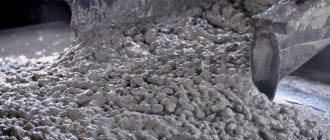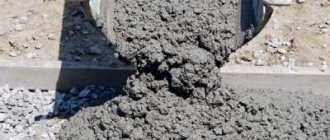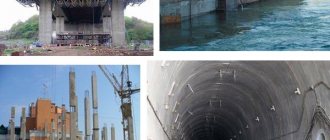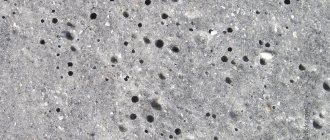The most common material on any construction site is concrete. The scope of its application is quite wide, and the addition of plasticizers and other inclusions in the composition allows you to adjust the strength characteristics of concrete to the desired object. Both purchased and self-prepared concrete must be checked for strength and uniformity to avoid collapse during operation.
In construction, concrete is used both in the form of blocks and in the form of monoliths. Scope of application: from finishing to frame and foundation work. Concrete grades are used from M100 to M400, where as the coefficient increases, the level of strength also increases. The grade shows the compressive strength.
Determining the grade of ready-made (from suppliers) or already poured concrete can be done using special instruments, in the laboratory, or independently at the construction site. Each method differs in accuracy coefficient and has its own nuances.
Testing methods can be destructive or non-destructive. In destructive cases, the brand is determined in laboratory conditions. The standards are compressed using a special hydraulic machine. The concrete cube standard is subjected to gradually increasing pressure and the maximum value is noted when the sample is destroyed. This pressure indicator indicates the characteristics of the corresponding grade of concrete. Next, we will consider non-destructive methods.
Contact verification methods
The first method is simple, convenient and the most common: it is carried out using special professional equipment. This testing method includes mechanical control based on the impact on the concrete base. These devices look like pistols with a rod striker. A sclerometer (also called a hardness tester) determines the hardness of concrete using the rebound method. A steel ball at the end of the device is pressed against a concrete surface, and the resulting imprint is measured. After making several such approaches, the average is calculated. In this way, data is obtained on the strength of concrete, its grade, uniformity and elasticity of the composition.
The sclerometer can be electronic or mechanical; its price is quite high, so it is not worth buying a device for one-time use. In addition, builders prefer newer approaches to this method.
The second method of verification is laboratory testing of samples. To determine the quality of hardened concrete, special samples are used; they are poured simultaneously with the bulk of the material:
- A wooden cube is made (10.15 or 20 cm³ in volume), the edges of which must be impregnated with water or a special lubricant;
- The purchased concrete mixture is poured into the mold directly from the concrete mixer using the layer-by-layer method;
- The poured solution is compacted, a couple of holes are made with fittings to remove excess air;
- The sample is then placed for approximately 4 weeks under the same conditions as the fundamental structure;
- After “ripening”, several finished samples are transferred to the laboratory for testing.
It is important to compact the samples by which the brand of the composition is determined, dry them well, and also store them properly and protect them from damage. Therefore, storage is carried out at approximately 20⁰C and a humidity of about 90%, because the strength changes during the hardening process.
Diagnostics can also be carried out at intermediate stages of setting - these are 3, 7 and 14 days. Based on the research, the laboratory examination will issue a conclusion whether the sample meets the stated standards for the required grade of concrete. This method is noted as the most accurate percentage compared to other methods.
Ultrasound technique
This technique is based on the speed of propagation of ultrasound in concrete (reaches 4500 m/s). Using this criterion, the level of compressive strength can be determined. There are several types of sound:
- surface (used for floor slabs and panels), the wave converter is located on the side of the control zone;
- through (suitable for beams and columns), devices are installed on opposite sides of the object.
Ultrasound equipment includes an electronic module and special sensors that convert sound vibrations into digital data. However, it is important to remember that the ratio of sound speed and strength depends on many factors:
- concrete compaction level;
- possible excess consumption of cement;
- method and process of mixing concrete raw materials;
- quality and quantity of concrete grain composition;
- presence of defects in the design.
Ultrasonic testing is suitable for mass testing; it is practiced in factories and industries. The disadvantage of this method is the error in the transition from acoustic to strength indicators. Ultrasonic measurement devices have increased accuracy, but testing with them requires certain skills and knowledge. In addition, they are very expensive, and not everyone can afford the services of a good flaw detector.
How to check concrete performance in the laboratory
If, when producing a mixture at an enterprise, the technology and proportions are strictly followed, the components are selected, and there are no low-quality fillers, the quality of the finished product will undoubtedly be ideal. But just in case, it is recommended to prepare samples for subsequent control. They will be tested in a laboratory using the compression method and an expert opinion will be issued.
In order to fully accurately determine the quality of the finished concrete and its compliance with the specifications, it is necessary to pre-make formwork in the form of cubes with an edge size of 100 mm. After the concrete has matured, the samples need to be delivered to a laboratory, where they know exactly how to check the grade of concrete. This procedure is carried out after compaction (vibration) and drying under the same conditions in which general filling was carried out.
Checking and clarifying the brand of the resulting concrete, as well as issuing a certificate, must be carried out after the mixture has fully matured, after 28 days.
Visual method
You need to carefully inspect the mixture when unloading. Heterogeneity, stratification of the composition, yellow color and the presence of water indicate non-compliance with the filling rules. Cold shades of gray, smoothness, evenness and the presence of cement laitance with a viscous consistency, on the contrary, indicate the quality of the mixture.
Also, the size and type of dents after testing with a hammer for strength may indicate the strength of the hardened concrete. There should be practically no cracks, dents are almost invisible.
If the solution is delivered by mixer, it is not possible to determine the quality of the concrete visually only by the delivery notes provided.
How to find out the quality of concrete before pouring
It is possible to accurately find out certain characteristics of a mixture only in a laboratory that operates at every large enterprise. After all, concrete M350 or M400 looks almost the same as M100. When ordering a batch, the client is forced to trust the passport and documents for the ordered delivery, which are presented by the mixer driver. To do this, you need to carefully review the certificates provided.
Next, you should pay attention to the brand indicated by the manufacturer, as well as the time when the invoices were issued. After all, a vehicle makes many trips per day, and the documents presented for unloading may not correspond to the shipment actually delivered to the construction site. There are also signs by which experienced craftsmen can roughly evaluate the brand.
Voice check
There is also a sound test by striking (with a hammer weighing up to half a kilogram) on a concrete base. A dull echo indicates insufficient strength and density. And if the concrete at the point of impact begins to crack and crumble, then everything should be changed or redone, otherwise the structure may completely collapse.
Tool check
One of the easiest ways to find out the strength of a concrete pour is with a chisel and hammer. A chisel is applied to the hardened concrete and the chisel is struck with a gentle blow from above. Then the depth of the dent is assessed.
- If the chisel easily entered the concrete, it means that the grade of concrete is below M70-M75;
- The chisel plunged 5-10 mm - concrete grade M75-M100, class B5;
- A chisel immersion of less than 5 mm means that the concrete is class B10, grade M100-M150;
- A small dent remains on concrete class B15-25, grade M200-250;
- If the chisel leaves a barely noticeable dent or there is none at all, then this means that you are looking at concrete of class B25, and the grade of concrete is from M200 to M350.
All the methods described above have their advantages and disadvantages, but for greater accuracy it is better to contact specialists. Ultrasonic, laboratory and shock-pulse studies are still the most reliable, because a professional can more accurately determine the degree of delamination, the required color and types of “patterns” on concrete.
Test stages
Concrete testing is carried out by examining samples for strength using non-destructive and destructive methods.
Destructive methods
This method involves testing using a press, when gradually increasing pressure is applied to a sample obtained during laboratory casting or cut from the base of a finished structure. The impact continues until the destruction of the sample is detected.
This method is the most accurate and mandatory when carrying out work on the construction of critical structures.
Non-destructive methods
To obtain results when using non-destructive testing methods, special instruments and devices are used. Partial destruction is carried out by fixing a special tool on the concrete surface, which allows you to examine the concrete for tearing, recording the required force.
The reaction of the material to shearing is also studied when the device is installed on the corner of a concrete base and the material is destroyed under load.
Separation with chipping.
Under shock loads, the behavior of concrete during impact is studied with a special device and the reaction to elastic rebound is recorded - the value of the rebound of a metal ball released with a certain force is measured.
During ultrasonic quality control of concrete, a special device is used that makes it possible to record the passage of waves inside the structure. Based on the reaction to reflection, a conclusion is drawn about the quality of the material.
Sclerometer.
How to test the strength of concrete yourself? It is impossible to obtain a complete study of the material at home. Quality control of the material can be done exclusively by visual methods. A high-quality mixture usually has a gray or gray-green color; the structure of the solution should be uniform, with normal viscosity.
If the material has a yellowish tint, this means that the quality of such a solution is low and its composition contains impurities that reduce the strength characteristics. A good sign is the discovery of a thick consistency of cement laitance on the surface of the solution.
Under impact loads (hitting a material that has gained full strength with a hammer), the tool should bounce off the base without significant changes on the surface, leaving almost invisible dents.
Is it possible to visually distinguish good concrete from bad?
Sometimes it is not possible to conduct laboratory research and the decision to purchase material must be made based on visual observation. There are several recommendations to help you make the right choice:
- The mass of building material must have a uniform consistency without lumps or impurities;
- The color of good concrete is usually rich gray. If it has shades of brown, it means that a large amount of sand was used during mixing in order to save money. An excess of additional plasticizers can give a reddish tint;
- If possible, do a test pour on a small area. Proper concrete will pour out as a thick, viscous mass without lumps.
When concluding a contract for long-term cooperation, it is worth using the help of independent expert laboratories that will give a professional, reasoned answer about the quality of the product.
Tensile test procedure
To perform tensile tests, you will need to prepare a sample of an elongated prism-type shape. This sample is placed in a special device in a horizontal position, then a force is applied to the middle of the sample with increasing load. The step of the impact on the sample is 0.5 MPa/s.
The result is recorded after the destruction of the concrete structure in the central part of the sample.
Features of marking mixtures and ready-made concrete products
The brand of concrete can be understood by the markings indicated in the accompanying documentation for the products. The decoding procedure is easier to study using a specific example. As part of “BST V15 P4 F150 W6” the presented symbols indicate the following parameters:
- BST indicates the type of solution (heavy); the abbreviations BSM and BSL respectively mean fine-grained and lightweight concrete mixture;
- B corresponds to MPa strength class;
- P means the degree of workability (movable); the presence of the letters Ж and Р indicates a hard or spreading mixture;
- F frost resistance; frozen and moisture-saturated material will not lose strength after specified cyclic changes in temperature conditions from negative to positive;
- W value of water resistance; values are provided in the range from 2 to 20, which corresponds to the maximum water pressure in MPa? 10-1, at which the material does not absorb moisture.
The manufacturer and the accredited laboratory that conducted the tests are responsible for the reliability of the characteristics to which the class (grade) of concrete corresponds according to the presented markings.
The provided methods for monitoring the strength of concrete allow you to check the quality of the resulting material to ensure that the required performance characteristics are achieved. After all, people’s lives depend on the integrity of concrete structures.
Areas of use of different grades of concrete
Concrete has become widespread and is used to create foundations and many other structures. Depending on the purpose of use, concrete of one or another brand is selected. Here are the main areas of use of the most common grades of concrete:
used to create road curbs and before pouring a strip foundation;
M100- M150 is suitable for pouring floors, foundations for fences, as well as for organizing parking for cars;
- M200 is used in the restoration of buildings, filling paths, as well as for creating blind areas and foundations of light buildings;
- M250 is suitable for creating different types of foundations, as well as for platforms and paths;
- M300 is used to create the foundation of brick houses, paving slabs and roads subject to heavy loads;
- M350 is suitable for creating monolithic foundations and foundations for multi-story buildings;
- M400 can be used both for creating the foundations of residential buildings and for the construction of bridges and structures on water;
- M450 and M500 are suitable for the construction of tunnels, sewers, bridges.
Strength testing of concrete, minimum sample sizes
Checking the mixture allows you to determine whether the structure being built meets the technical specifications in compliance with the provisions of SNiP and GOST. Conducted in the laboratory.
The measurement error results from:
- humidity of the test material;
- uneven composition of the solution;
- oiling the outer layer;
- reinforcement with metal rods;
- chips, cracks and other defects of the base surface;
- conducting research with a faulty device.
After the research, a “Document on the quality of the concrete mixture” is drawn up. It is used by the contractor when constructing buildings.
The class of concrete is established on samples measuring 150x150 mm, which are cast in the laboratory and harden for 28 days. They are subjected to increasing impact until destruction (GOST 10180-90). The maximum compression is fixed.
On what basis is the class established?
According to the classification adopted in the Soviet Union, concrete, like cement, was divided into grades based on strength. It reflects the maximum degree of compression that the base can withstand without deformation. This is an average (laboratory) indicator, measured in kgf/cm2. It shows the technical properties of the solution and the amount of cement in its composition. Currently European standards are used.
The class is the load that concrete can withstand before it fails. This parameter determines the actual strength of the material and shows an accuracy of 95%. Depends on the technology used in production. It is indicated in project documents. It is marked “B” and has an index from 5 to 60. It is measured in megapascals (MPa).
Strength correspondence table (GOST 26633-91).
| Class | Brand | Application |
| V 3.5 | M 50 | Preparatory work |
| AT 5 | M 75 | |
| B 7.5 | M 100 | |
| AT 10 | M 150 | Screeds, tracks |
| At 12.5 | M 150 | |
| At 15 | M 200 | Two-story buildings, stairs, monolithic walls |
| IN 20 | M 250 | |
| At 22.5 | M 300 | |
| At 25 | M 350 | Reinforced concrete products, swimming pools, multi-storey buildings |
| At 27.5 | M 350 | |
| At 30 | M 400 | Bridges, dams |
| At 35 | M 450 | |
| At 40 | M 550 | Hydraulic structures, metro, bridges, dams, storage facilities |
| At 45 | M 600 | |
| At 50 | M 700 | |
| At 55 | M 750 | Underground bunkers, bomb shelters, including radiation shelters |
| At 60 | M 800 | |
| At 65 | M 900 | |
| At 70 | M 900 | |
| At 75 | M 1000 | |
| At 80 | M 1000 |
Note! Testing concrete cubes for strength using a press is the most effective technique.











